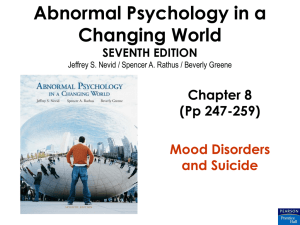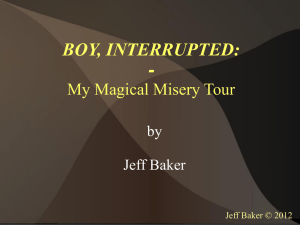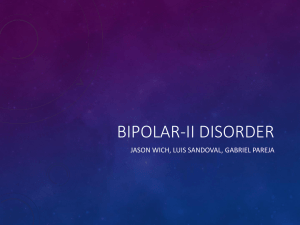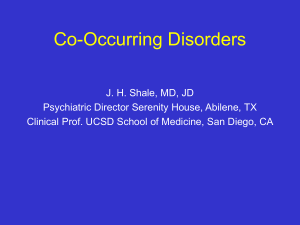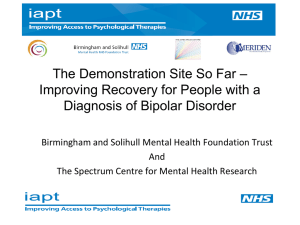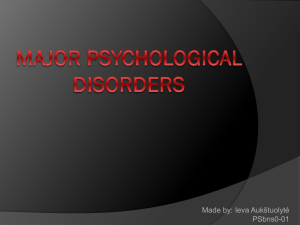TEWV FT Master PowerPoint
advertisement
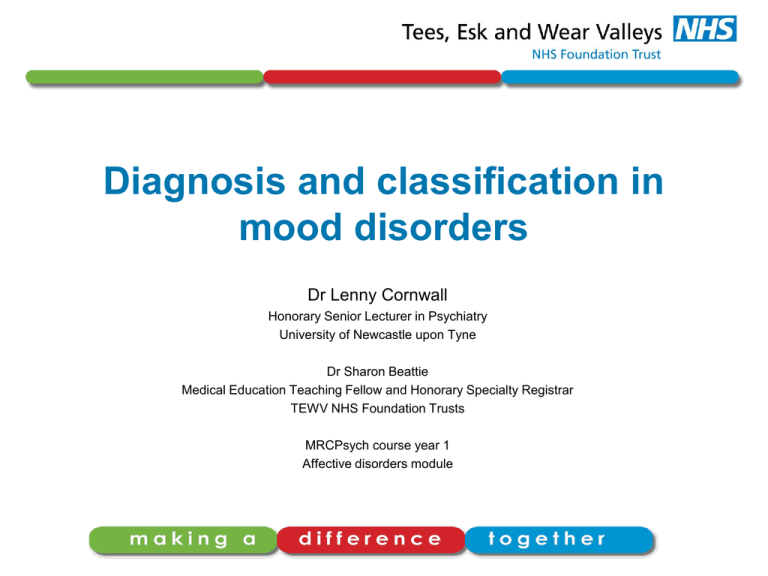
Diagnosis and classification in mood disorders Dr Lenny Cornwall Honorary Senior Lecturer in Psychiatry University of Newcastle upon Tyne Dr Sharon Beattie Medical Education Teaching Fellow and Honorary Specialty Registrar TEWV NHS Foundation Trusts MRCPsych course year 1 Affective disorders module Mood syndromes Mania M Hypomania m Depression D Depressive symptoms d Mood disorders DD unipolar major depression Dd unipolar major depression MD bipolar I Md bipolar I Dm bipolar II, bipolar NOS md cyclothymia dd dysthymia Diagnosis of MDD Diagnosis of exclusion rule out 20 depression usually no family history, no past history older age of onset rule out bipolar disorder Unipolar / bipolar distinction age on onset duration of episode genetics antidepressant prophylaxis symptomatology response to treatment pre-morbid personality Bipolar disorder Young and Klerman subtypes (1992) Bipolar I depression and mania Bipolar II depression and hypomania Bipolar III cyclothymia Bipolar IV antidepressant induced mania Bipolar V depression with FH bipolar Bipolar VI unipolar mania Bipolar spectrum disorder DSM-IV definition of hypomania - symptoms of elation lasting 4 days but with no functional impairment. Bipolar II disorder has prevalence of 0.5%. Reduce criteria for hypomania to 2 days and prevalence rises to 5.5%. Softening criteria further increases the rate of bipolar diagnoses to 50% of ‘unipolar’ cases of depression Mood Disorder Questionnaire Screens for Bipolar Spectrum Disorder Positive screen 7 or more out of 13 items from elation, irritability, self confidence, needing less sleep, more talkative, racing thoughts, distractible, ↑energy symptoms occurring concurrently moderate or serious level of problem Depression Affect transient state Mood pervasive state Syndrome longer duration, associated symptoms Small group task List diagnostic categories in which a depressive syndrome can occur. Depressive syndrome Organic depressive disorder (F06.32) Substance induced mood disorder (F1x.54) Schizoaffective disorder (F25.1) Bipolar disorder (F31.3) Depressive episode (F32) Recurrent depressive disorder (F33) Dysthymic disorder (F34.1) Mixed anxiety and depressive disorder (F41.2) Adjustment disorder (depressed) (F43.21) Emotionally unstable personality disorder (F60.3) Determinants of differential diagnosis of depression Aetiology organic depressive disorder substance induced adjustment disorder, depressed emotionally unstable personality disorder Course schizoaffective disorder bipolar disorder Clinical features dysthymic disorder mixed anxiety and depressive disorder Depressive subtypes DSM-IV severity, psychotic, remission specifiers chronic episode melancholic, catatonic or atypical features seasonal pattern post-partum onset ICD-10 severity: mild, moderate, severe somatic syndrome psychotic symptoms DSM-IV melancholia anhedonia OR unreactivity plus 3 of distinct quality DMV EMW retardation / agitation weight loss guilt ICD-10 somatic type At least 4 of anhedonia unreactivity EMW DMV retardation / agitation weight loss loss of libido The first description of types of depression – the start of the depression debate? St Paul, 2 Corinthians 7:10 “For godly sorrow worketh repentance to salvation not to be repented of, but the sorrow of the world worketh death” depression from God (inexplicable / endogenous) depression of the world (reactive / exogenous) The Depression debate The three principle models are argued for on basis of presumed number of types: one (unitarian), two (binary model) & many (depression spectrum). Arguably dates back to St Paul’s original comment in the bible – endogenous vs exogenous, the binary model. 1926 British psychiatrist Mapother proposed – both ‘psychotic’ & ‘neurotic’ forms are on spectrum of one type of depression. Study by Lewis in 1930s seemed to support unitarian view 1973 influential paper by Akiskal & McKinney again supporting the Unitarian view Evidence/discussion proposing alternative classification Paykel (1971) Parker (2000) Paykel (1971) Article in British Journal of Psychiatry 165 depressed patients were subjected to special cluster analysis for classifying people Cluster analysis from heterogeneous sample identified 4 groups psychotic / endogenous depression anxious “neurotic” depression younger, hostile patients younger patients with personality disorder Parker (2000) psychotic melancholic may deny / minimise depressed mood constipation common good response to ECT non-psychotic melancholic observed psychomotor disturbance non-melancholic hostile subtype externalise anxiety, cluster B personality anxious subtype internalise anxiety, cluster C personality better response to SSRIs Parkers hierarchical model Parker’s schematic model Using Parker’s model in practice 1. Is a depressive disorder present? 1. symptoms, duration, severity 2. If yes, what is the likely subtype? 1. unipolar 1. psychotic: presence of psychotic symptoms 2. melancholic: presence of psychomotor disturbance 3. non-melancholic: by default 1. 2. 2. bipolar distal / proximal stressors hostile / anxious personality style Why challenge/change the Unitarian Paradigm If this is flawed concept then this has impact on: Research (esp neurobiological research) Treatment Utility If different subtypes exist this could have treatment specific implications If it is correct then we need to develop a more sophisticated understanding DSM V & ICD 11 Latest evidence to inform changes Co-morbidity studies in USA Netherlands Australia DSM V final version due May 2013 Proposed revisions available at www.dsm5.org ICD-11 11th revision due by 2015 Krueger (1999) Is co-morbidity noise or signal? noise – try to avoid and seek pure cases of disorder signal – an indication that current diagnoses are inadequate US national co-morbidity survey (n = 8098) diagnostic data analysed by factor analysis for 10 common mental disorders, including depression 3 factor model best fit: internalising disorders – anxious / misery internalising disorders – fear externalising disorders Copyright restrictions may apply. Vollebergh et al (2001) Netherlands mental health survey (n = 7076) latent structure of 9 DSM-III-R disorders 3 dimensional model had best fit substance misuse disorders mood disorders depression, dysthymia, GAD anxiety disorders panic disorder, agoraphobia, simple phobia, social phobia Slade & Watson (2006) Australian co-morbidity survey (n = 10641) best model to fit 10 common mental disorders 3 factor model internalising disorders – distress factor major depression, GAD, PTSD, neurasthenia internalising disorders – fear factor panic disorder, agoraphobia, OCD externalising disorders alcohol & drug misuse replicates findings of Krueger A new proposal for DSM V & ICD 11 Andrews, Goldberg, Krueger et al (2009) Neuro-cognitive disorders neural substrate abnormalities Neuro-developmental disorders early & continuing cognitive deficits Psychotic disorders biomarkers for information processing deficits Emotional disorders temperamental antecedent of negative emotionality Externalising disorders temperamental antecedent of disinhibition “By three methods we may learn wisdom: first by reflection, which is the noblest; second by imitation, which is the easiest; and third by experience, which is the bitterest” (Confucius, 551 – 479 BC)




